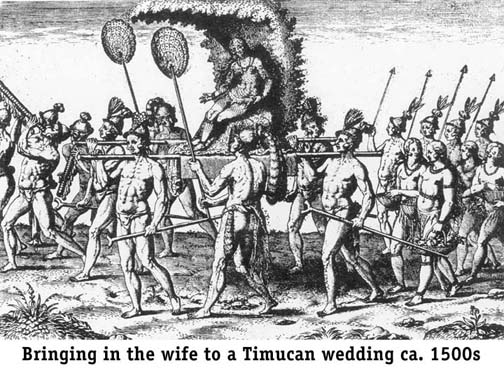|
INDIANS By Jerry Wilkinson |
 |
|
INDIANS By Jerry Wilkinson |
 |
|
From the beginning, the human race has progressed to higher and more
efficient
life styles. The various Indian cultures banded together into what we
now
call tribes. Those that were here when Columbus made his voyage are
referred
to as historic Indians or pre-Columbian Indians. Therefore, with the
arrival
of the white man and his written language, out went the prehistoric
times
and in came the historic times. Fragments of written evidence, such as
hand written ship logs and guides (derroteros) began to appear.
At the beginning of the historic period, in 1492 AD, it is conservatively estimated that there were about 100,000 Indians living in Florida. Some estimate as many as 350,000. Accepting the first estimate, the distribution is thought of as this: Timucuans in the northeast, 40,000; Apalachee and Pensacola in the northwest, 25,000; Tocobaga in the west-central, 8,000; Calusa in the southwest, 20,000; Tequesta in the southeast, 5,000; Jeaga, Jobe and Ais (pronounced 'ice') in the east-central, 2,000. There were others, as well as sub-groups, i.e., Saturiwa, Santaluces, Boca Ratones, Tocobaga, etc. By the late 1700s, it is thought that all of these indigenous Indians were gone. Also, note that there is no mention of the Seminoles, as they did not enter Florida until the early 1700s. Please be aware that all these Indian names, and those given later, were names given by their so-called educated new world explorers, primarily Europeans. The presumed names would be recorded phonetically by each writer. Even the Seminoles, who are not indigenous Florida Indians, never did -and still do not- call themselves Seminoles when speaking privately among themselves. There exists considerable debate about which historic Indians were the early inhabitants of the Keys. Historians are relatively certain that the Florida West Coast Calusa was dominant and exercised political control over the east coast Tequesta's. However, the two tribe's pottery differs and fragments of pottery found in the Keys often indicate presence of the Tequesta, but the living areas (middens) were shell mounds indicating Calusa. There is also mounting evidence that the Caribbean Island Indians may have also inhabited the Keys. The present archaeological evidence is not conclusive, other than the general reference by early European travelers to the Matecumbes as the Keys Indians.
I recommend that the serious Florida Keys' Indian student consult the 1991 and 1994 published books by John Hann titled Missions to the Calusa, Tacachale edited by Milanich and Proctor, and Florida's First People by Robin C. Brown. One problem that I found was when the Spanish used the word transcribed as " Cayo or Key", how does one know if it is the Monroe County Keys or some other Florida Key such as those on Florida's west coast. The only time I feel certain is when they refer to the Martyrs. Often the term "Keys Indians" included the Calusa, Tequesta and other south Florida Indians. The Spanish did most of the early historic writings of the Keys and the following is presented to introduce the Indian/Spanish attitude in these early times. When Christopher Columbus made his second voyage to Cuba in 1494 with his son Diego as second in charge, the Indians were absolutely friendly. Seventeen years later, when Diego sent Diego Velasquez to Cuba, he was greeted with a cloud of arrows. Chief Hatuey had crossed the Windward Passage from Hispaniola to Cuba and had informed the local natives how terribly the Spanish in Hispaniola were treating the Indians. Ponce de Leon was not treated as badly by the Florida Indians on his first trip in 1513 as he was on his second voyage in 1521. It is generally assumed that Spanish slave ships had visited the Florida coast in between De Leon's voyages and had alienated the Indians. The slavers were visiting the Americas as early as 1502. It was reported that the Indians screamed Spanish words at Ponce de Leon on his second trip. How else could they have so quickly learned Spanish words? More on Ponce later. Anyway, relations between the Indians and the Spanish went from bad to worse as time passed, although it was not always predictable. There were many mixed stories. In 1565, Pedro Menendez on his first trip rescued Spanish survivors who had lived with the Calusa for 20 years. They had survived the supposedly one-a-year sacrifices to the gods. Hernando de Soto, in 1539, found Juan Ortiz near Tampa. Ortiz had been allowed to live by the intercession of Tocobagan Chief Ucita's daughter and had even been traded among tribes. (This was 68 years before the John Smith-Pocahontas event at Jamestown.) On the east coast of Florida, a silversmith was allegedly spared to fashion silver articles for his captors from salvaged shipwrecks. It seemed that when the European explorers landed on the Florida coasts in the 1500s, the very first thing they did was to kill somebody. The Spanish, French and English killed each other if no one else was available. The Indians came to expect this from the Europeans. This made it very difficult and dangerous for innocent shipwreck victims and missionaries to survive at the hands of the wary Indians. One of the better documented accounts of the early Indians is found in the memoirs of Hernando d'Escalante Fontaneda, who was shipwrecked around 1549 when he was 13 years old. He was taken captive by the Florida Indians and lived with them for 17 years before being released and returned to Spain. Some seven years later, the mature Fontaneda wrote his memoirs, which have been translated into English. We are not sure of the location where he was shipwrecked, how he survived and the exact extent of his travels, although they were quite extensive. However, Fontaneda does give an understandable description of the Keys (islands nearer to the mainland) and even names the two villages of Cuchiyaga and Guarugunbe. (Variations of these two names appear in many early Spanish maritime records.) He gave a few hints of where they were located. He knew the ocean channels and understood the position of the Keys in respect to Cuba and the Bahamas. References were made to the Calusas, the Tequestas and the Lake of Mayaima, et cetera, but he does not name the Keys' group of Indians specifically. To read a translation, Click HERE. Another account is the Jonathan Dickinson Journal first published by the Quakers in 1699. Jonathan Dickinson, his wife and infant son, and a party of about 20 in all were shipwrecked on the Florida East Coast in 1696. He recounts their harrowing journey from Indian village to village to reach St. Augustine. Copies of both are in most libraries. For Keys history, the Native Americans that were here started the wrecking industry, an industry that was continued into the late 1800s. They salvaged the crews, cargoes and flotsam of wrecked ships. About all that changed when the Bahamians and Americans became involved were the methods and means of disposal. More about wrecking later. There is also a petition to Spain by Pedro Menendez in 1573 of an incident with the Matecumbe Indians. Eight Spanish were killed and one was spared. He was kept as a slave and fed by an Indian friend. Who were the Matecumbes? Were they Tequesta, Calusa, or a separate group? One explanation is that every time a Spanish group met a group of Indians, regardless of size, they gave them names. By the 1600s the word was out and the Indians were smarter. For one thing, they were trading with the Spanish much more. Gonzalez de Barcia reported they were selling cardinals (the red birds) to the Spanish crews for $6 and $10 apiece. European diseases were by now taking a heavy toll on the indigenous Indians who possessed no immunity, even to the simplest European disease. Spanish fishermen from Cuba began to fish cooperatively with the Native Floridians. Soon a sizable trade industry existed between the two cultures. In 1711, the Catholic Bishop in Havana sent two ships under Captain Luis Perdomo to rescue Indians of the Keys. Havana had received word that British backed Indians from North Florida were destroying South Florida villages and selling the Indians as slaves. These northern Indians were most likely portions of the Creek Confederacy, later known as the Seminoles. Captain Perdomo brought back 270 indigenous Indians, but said he would have brought more than 2,000 had he had the vessels. Of the 270 refugees, 200 died of European diseases in Cuba and 18 returned to Florida. In 1743, another attempt was made, but the priests did about as much harm as good. The priests admitted setting fire to an Indian house of worship and to committing other acts against perceived idolatry, but the Indians stood fast in their beliefs. In 1743, Spain sent Fathers Josephs Alana and Monaco to the Florida Keys as missionaries. After stopping at Cayo de Guessos (Key West) and Cayo Frances (Indian Key), they settled at the mouth of the Miami River. In truth, Virginia Key and Key Biscayne are Florida Keys. The next year the mission was canceled. The Spanish had been bringing "Keys Indians" to Havana since 1704 and they either died or "scattered until they returned to the Keys." The last major exodus occurred when the Spanish traded Florida to England. Bernard Romans wrote in 1763 about 80 indigenous Florida Indian families who had fled from the Keys on a ship bound for Havana. Present documentation seems to suggest that the embarkation occurred from St. Augustine. Some of these may have returned later to form the "Spanish Indians." Some may have hidden in the Everglades. The Florida Indians, indigenous and immigrant (Seminole), were being annihilated in Florida by disease, by the white man or by their own kind. Over a century later in 1880, it is reported that only 208 Seminoles remained and the Seminoles themselves had been immigrants to Florida for no more than two centuries. The Seminoles are on a separate web page.
In summary, indigenous natives lived in the Keys until early 1700. They
shared the Keys with the Creeks, later to be known as Seminoles, until
around 1770. Afterwards the Keys were primarily used by the Seminoles.
Note: In 1771 the Florida Creeks and their associates began to be
referred
to as Seminoles.
-----End------ Return to General Keys History |
